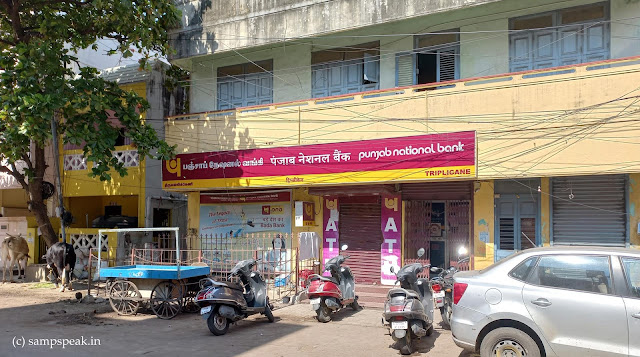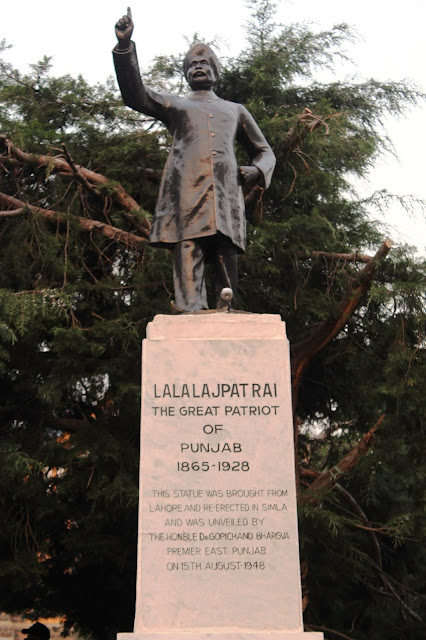Indian
history has not accorded the right place for many a martyrs ~ not at all
surprising as we read history as dictated by the British, further refined by
commies – natural that many remain unsung, unknown
martyrs. Most of us do not even know
that lion Lala Rajpat Rai actually succumbed to
murderous attack made by British Police !!
~ Indian freedom struggle is much
much more than Gandhi, Nehru, and Congress.
பாரத விலாஸ் 1973 ஆம் ஆண்டு வெளிவந்த தமிழ்த் திரைப்படம். ஏ.சி. திருலோகச்சந்தர் இயக்கத்தில் சிவாஜி கணேசன், கே. ஆர். விஜயா மற்றும் பலரும் நடித்து இருந்தனர். மொழி இன சமய பல்வகைமை கொண்ட இந்தியாவின் ஒற்றுமையை விளக்கும் விதமாக ஒற்றை குடியிருப்பை மையமாக வைத்து மொழி இன வெறுபாடின்றி ஒற்றுமையை வலியுறுத்தும் விதமாக இதன் கதை அமைந்தது. அப்படத்தில் திரு வாலி இயற்றி, எம்.எஸ். விஸ்வநாதன் இசையில் - டி.எம். சௌந்தரராஜன், பி. சுசீலா, எல்.ஆர்.ஈஸ்வரி, ஏ.எல். ராகவன்; திரு கே வீரமணி ஆகியோர் பாடிய பிரபல பாடல் :
இந்திய
நாடு என் வீடு - இந்தியன் என்பது என் பேரு
எல்லா மக்களும் என் உறவு - எல்லோர் மொழியும் என் பேச்சு
இப்பாடலின் பின்பகுதியில் வரும் வரிகளில் ஒன்று :
பஞ்சாப்
சிங்கம் லாலா லஜபதி - பகத்சிங் பிறந்த பொன்நாடு
This branch of Punjab National Bank, at Singarachari Street, Triplicane (opp to
Samarao school) is quited old. PNB as we
know, is a Nationalised bank, headquartered in New Delhi and some of us may
have our account here. Not sure whether
you have observed this portrait ! and thought of its history too !!
When the Simon Commission visited Lahore on 30 October 1928, Lala Lajpat Rai led a peaceful protest against the Commission. The superintendent of police, James A Scott, ordered his men to lathi charge the protesters. Lala Lajpat Rai was badly injured in the baton-charge but addressed a meeting later. He died on 17 November 1928.
On 28th Jan 2022, it would be 157th birthday of this great patriot. Lala Lajpat Rai (28.1.1865 – 17.11.1928) popularly known as Punjab Kesari, was one of the three members of the Lal Bal Pal triumvirate.
Rai
was born on in Agarwal Jain family, s a son of Urdu and
Persian government school teacher Munshi Radha Krishna Agarwal and his wife
Gulab Devi at Dhudike in Ludhiana district of Punjab. In the late 1870s, his
father was transferred to Rewari, where he had his initial education in
Government Higher Secondary School, Rewari, Punjab province, where his father
was posted as an Urdu teacher. In 1880, Lajpat Rai joined Government College at
Lahore to study law, where he came in contact with patriots and future freedom
fighters, such as Lala Hans Raj and Pandit Guru Dutt. While studying at Lahore
he was influenced by the Hindu reformist movement of Swami Dayanand Saraswati,
became a member of existing Arya Samaj Lahore.
In 1886, he moved to Hisar practiced
law and became a founding member of the
Bar council of Hisar along with Babu Churamani. In the same year he also
founded the Hisar district branch of the Indian National Congress. He was also a journalist and was a regular
contributor to several newspapers including The Tribune. In 1886, he helped
Mahatma Hansraj establish the nationalistic Dayananda Anglo-Vedic School,
Lahore.
In 1914, he quit law practise to dedicate himself to the Indian independence movement and travelled to Britain, and then to the United States in 1917. In October 1917, he founded the Indian Home Rule League of America in New York. Lala Lajpat Rai, Bal Gangadhar Tilak, and Bipin Chandra Pal were a triumvirate of assertive nationalists in British India from 1906 to 1918. They advocated the Swadeshi movement involving the boycott of all imported items and the use of Indian-made goods in 1907.
After joining the Indian National Congress and taking part in political agitation in Punjab, Lala Lajpat Rai was deported to Mandalay, but there was insufficient evidence to hold him for subversion. He was elected President of the Indian National Congress in the Calcutta Special Session of 1920. In 1921, he founded Servants of the People Society, in Lahore. From USA, he returned during World War I. He was imprisoned from 1921 to 1923 and elected to the legislative assembly on his release.
In 1928, the United Kingdom set up the Simon Commission, headed by Sir John Simon to report on the political situation in India. The commission was boycotted by Indian political parties because it did not include any Indian members, and it was met with country-wide protests. When the Commission visited Lahore on 30 October 1928, Lajpat Rai led a non-violent march in protest against it and gave a slogan "Simon Go Back". The protesters chanted the slogan and carried black flags. The police superintendent in Lahore, James A. Scott, ordered the police to lathi charge the protesters and personally assaulted Rai. Despite being severely injured, Rai subsequently addressed the crowd and said "I declare that the blows struck at me today will be the last nails in the coffin of British rule in India".
In 1927, Lajpat Rai established a trust in his mother's memory to build and run a tuberculosis hospital for women, reportedly at the location where his mother, Gulab Devi, had died of tuberculosis in Lahore. After he died arising out of the brutal attack, in 1928, Bhagat Singh and Shivaram Rajguru shot dead John Saunders, British assistant superintendent of Lahore police, avenging lathi charge of Lala Lajpat Rai.
Recently, I was surprised to see his photo inside the Punjab National Branch at Triplicane and now read that he was associated with PNB and Lakshmi Insurance Company in their early stages in 1894. Here is something extracted from the web page of PNB.
`PNB was born on May 19, 1894. The founding board was drawn from different parts of India professing different faiths and a varied back-ground with, however, the common objective of providing country with a truly national bank which would further the economic interest of the country. The Bank opened for business on 12 April, 1895. The first Board had 7 Directors. Punjab under the British especially after annexation in 1849 witnessed a period of rapid development giving rise to a new educated class fired with a desire for freedom from the yoke of slavery. Amongst the cherished desires of this new class was also an overriding ambition to start a Swadeshi Bank with Indian Capital and management representing all sections of the Indian community. The idea was first mooted by Rai Mool Raj of Arya Samaj who, as reported by Lala Lajpat Rai, had long cherished the idea that Indians should have a national bank of their own.
At the instance of Rai Mool Raj, Lala Lajpat Rai sent round a
circular to selected friends insisting on an Indian Joint Stock Bank as the
first special step in constructive Swadeshi. Lala Harkrishan Lal who had
returned from England with ideas regarding commerce and industry, was eager to
give them practical shape. Lala Lajpat
Rai was the first to open an account with the bank which was housed in the
building opposite the Arya Samaj Mandir in Anarkali in Lahore. Lala Lajpat Rai joined the Board of
Directors soon after !
Another interesting fact is that the statue now in Shimla was originally installed in Lahore and later brought to Shimla, unveiled by Dr Gopichand Bhargava, Premier of East Punjab in 1948.
16th Jan 2022.
Pic of Lajpat Rai statue : https://commons.wikimedia.org/wiki/File:Lala_Lajpat_Rai_Statue,_Shimla_01.jpg





No comments:
Post a Comment